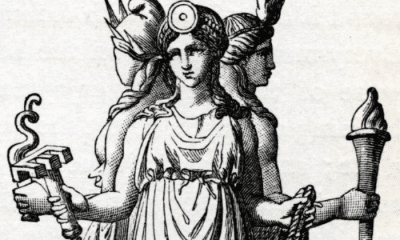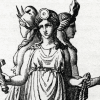Greek
Four Facts You Didn’t Know About Dionysus
If you think you know all there is to know about the Greek god of wine, think again! Here are four things you might not have known about Dionysus!
Dionysus, the god of wine, is a major figure in Greek mythology. He brought both joy and madness through intoxication and revelry.
He was also one of Greek mythology’s most complicated figures. From his birth story to his adventures on earth, the god of wine has many unusual and sometimes contradictory myths.
While his love for revelry and the madness of his followers are remembered well, many of the god of wine’s legends are not as well-known today. Here are four things you might not have known about Dionysus, the Greek god of wine!
Dionysus Had Three Births
Many Greek gods have very well-known birth stories. Athena, for example, was famously born from Zeus’s head after he swallowed his first wife, Metis.
Dionysus, unusually, has several birth stories.
Because the legends of his birth were told at a time when there was no unified state religion, different local traditions arose. Eventually, writers would try to combine these stories into a single cohesive narrative.
According to the story that was pieced together from the various local myths, the first birth of Dionysus was early in the history of the gods. Zeus went to the Underworld and conceived a child with Persephone in a story that was favored by many mystery cults.
The first incarnation of Dionysus was shown as a bearded man. He had prominent horns because, according to one tradition, he had taught humans to tame oxen to plow their fields.
This Dionysus was Zeus’s most beloved child. Zeus brought him to Olympus and seated him on his throne, intending to make the young god his heir.
Hera was furious, however, that Dionysus was favored over her own son, Ares. She enlisted the help of the Titans to attack and dismember Dionysus.
In this story, many of the Titans were imprisoned in Tartarus not because they had originally fought Zeus in the Titanomachy, but because they killed his son.
They had dismembered him so fully that only a few pieces of his heart could be found, by Athena according to one source. Zeus took these small fragments and made an elixir that contained the god’s essence.
He gave this elixir to a mortal girl named Semele. In some traditions she was a priestess, while others claimed that she was the daughter of Harmonia and Cadmus.
The second birth story of Dionysus is the more well-known of the two. Semele became pregnant with Zeus’s child and attracted the attention of Hera as she celebrated her divine child.
Hera disguised herself as Beroe, Semele’s nurse, and advised the girl to have her lover prove his identity by showing her his true form. Zeus tried to resist, but eventually showed Semele a small fraction of his divine nature.
This was enough to overwhelm the girl’s mortal mind. Semele burst into flames and was killed.
Zeus was able to cut the child out of her womb, however, to save him. Because the baby was still underdeveloped, he sewed his son into his own thigh until he had grown enough to be born.
Dionysus was thus sometimes called the god that was born three times. The first birth was to Personphone, the second to Semele, and the third from Zeus himself.
He Introduced Wine Throughout the World
Hera’s campaign against Dionysus did not end with his final birth, however. Like many of Zeus’s sons, she remained antagonistic to him.
According to many legends, Dionysus was raised in hiding to avoid Hera’s anger. Wood and river nymphs reared him far from Mount Olympus.
Hera discovered him, however, when he was grown. As she had with Heracles, she struck her stepson with madness.
Forgetting who he was and what his purpose was, Dionysus wandered the world for many years. Because he was still a god, and according to some myths linked to the fertility goddess Persephone, he still made wine grow wherever he went.
This explained, to the Greeks, why grapevines were found throughout the world. They had been unconsciously planted by Dionysus as he wandered aimlessly.
Eventually, Rhea found Dionysus and cured him of his madness. He returned to Olympus but still sometimes roamed the world to tend to the vineyards he had created.
This episode also established the role of Dionysus as the god of madness. Having been driven insane himself, he could inspire a similar state of mind to bring either ecstasy or punishment to others.
According to a later story, Dionysus did not stop traveling the world after his wine grapes grew.
A 5th century poem by Nonnus claimed that Zeus sent Dionysus on a military expedition to make the people of India worship him. Accompanied by an army made up largely of satyrs and maenads, he was largely successful because he introduced wine to the region.
The story of the Dionysiaca was not written in Classical Greece, but there is evidence that the Romans had some concept of Dionysus/Bacchus as a more militant god at earlier dates. His processions of followers were one of the inspirations for the Roman triumphs that celebrated victorious generals and the emperor.
Dionysus Was Not Welcomed in Many Myths
While the Romans showed Dionysus in triumph, many of his myths showed him as something of an outcast.
Dionysus was a god of madness and revelry whose followers were known for their unruly behavior. The maenads were said to be so frenzied in their worship of him that they would even rip men to pieces who intruded on their rites.
Because of these, the mythology of Dionysus is filled with stories in which Greek cities were unwelcoming or even hostile to the hedonistic god.
In the play The Bacchae by Euripedes, Dionysus tried to return to his mother’s home city, Thebes, after his mind was restored. The kind, who was his cousin, refused to believe his divinity and denounced his effect on the women of the city.
As a punishment, Dionysus drove King Pentheus insane and led him to the forest where the maenads were holding their secret revels. He was attacked by the maenads in their frenzy and killed by his own mother, Agave.
The king of Thrace was also cruelly punished for imprisoning the maenads in his country and threatening Dionysus. The god took refuge with Thetis and sent a drought against Thrace.
He then drove the king mad. King Lycurgus cut his own son to pieces with an axe, believing him to be a clump of ivy.
Dionysus then spread a rumor through Thrace that the land would be cursed with drought and ill fortune as long as Lycurgus lived. The people were inspired to revolt against him and the king was killed by a mob.
In several myths, Dionysus is only welcomed by people who do not know who he is.
At least two stories claim that Dionysus was taken captive by pirates who believed him to be a wealthy human prince or took him captive to sell him into slavery. These stories provided proof of his divinity, which was often doubted in his legends,
He Gave Midas His Golden Touch
The story of King Midas is still well-known today, but many people don’t realize that it was Dionysus who gave the legendary leader his golden touch.
According to legend, Silenus, the elderly satyr who had fostered Dionysus in his youth, went missing. He had drunkenly collapsed in King Midas’s property and been found by peasants.
The king welcomed Silenus and showed him hospitality. They feasted together for ten days and nights before Midas returned the satyr to Dionysus.
Dionysus offered the king anything he wished in thanks for treating his friend so well. Without thinking, Midas asked that anything he touched turned to gold.
The god of wine granted the favor, but told Midas that he wished he had made a better choice. The king, however, was thrilled when he touched a leaf and it turned to gold.
The kingdom quickly grew rich, but Midas realized the folly of his choice. Whenever he tried to eat or drink, the food turned into metal the second it touched his lips.
An addition to the story in the 19th century was even more tragic. Midas turned his own beloved daughter into a golden statue when he tried to give her a hug.
Midas prayed to Dionysus to take away the magical gift before he died of starvation. The god instructed him to wash in the River Pactolus to remove the power and to dip anything in the water that he wished to revert to its original form.
The water was imbued with gold as he bathed, explaining why the sands along the River Pactolus were rich in gold and electrum. King Midas was freed from his gift and learned the lesson to think of the consequences of his choices.
Dionysus in Greek Legends
There were many stories about Dionysus that were told in ancient Greece. Some of these are not well-remembered today.
Early Greeks had different birth narratives for the god. Later writers combined these to create a tradition in which he was killed and reborn.
The first Dionysus was the son of Persephone who was killed due to Hera’s jealousy. Zeus had him reborn to Semele, a human princess.
Semele was killed through Hera’s trickery, however, so Zeus himself carried the child to term. He sewed the baby into his thigh until he was ready to be born.
Hera continued to harass her stepson as he grew, driving him mad. He wandered the world and spread wine to other countries.
In a later story, he also traveled to India and waged war on the people there. He returned in triumph, inspiring Roman traditions.
He was not always welcomed in Greece, however. His divinity was often doubted and kings feared the wild recklessness of his followers.
Dionysus also played a role in the famous story of King Midas. While the king’s golden touch is a well-known story, many people do not realize that it was the god of wine who gave the king his regrettable power.
As a god whose powers were both loved and potentially problematic, the Greek people had a complicated relationship with Dionysus. His stories show that the god of wine was worshipped and mistrusted in equal measure.



